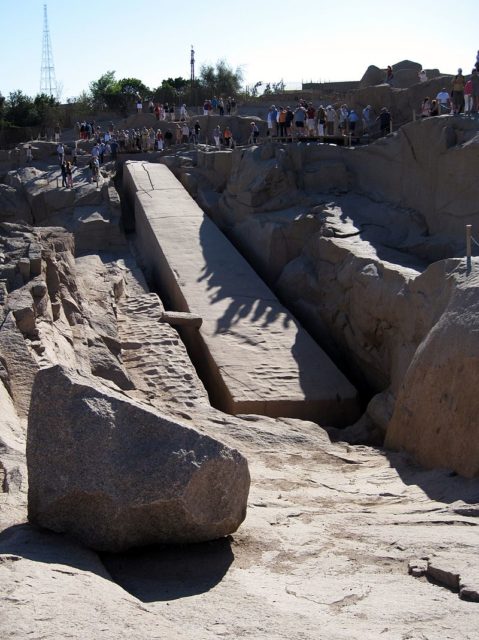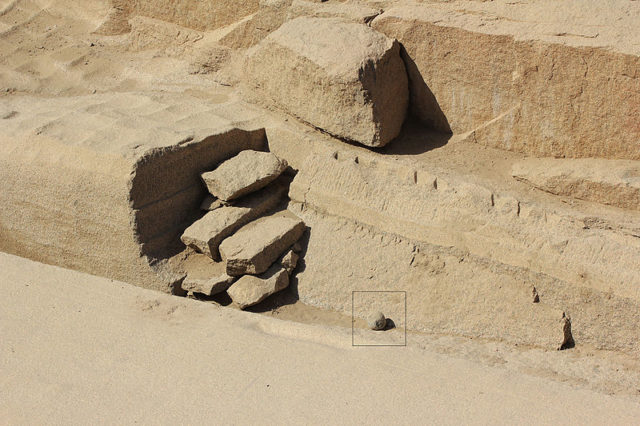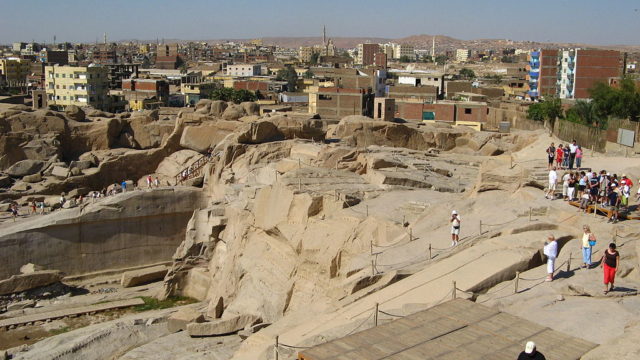The ‘unfinished obelisk’ is the largest ever known Egyptian obelisk and sits exactly where it was when it began to be carved out of the bedrock. This lump of stone was originally meant to be transformed into an obelisk that would stand 120 feet high and would have weighed in excess of 1,000 tons.

The obelisk still lays in this spot unfinished due to a crack running through the stone; this happened whilst attempting to carve the stone out from the bedrock. The stone then became useless and so was abandoned (estimated to be within the 18th Dynasty of Queen Hapshepsut).
Imagine the hours that went into creating the obelisk up until the point it became useless… and just how did they do this work in the first place? Scattered around this site there are numerous diorite pounding stones; these stones are only a little bit harder than granite. Engineers attempted to pound granite with balls made of diorite to see how effective they would be and the length of time it would take to get anywhere. It was estimated that it would take eight months of pounding to release the obelisk from its setting in the bedrock.

Christopher Dunn, an engineer, figured out that it would most likely take far longer than this 8 month period to complete this task and made it nigh on impossible in the conditions the workers had in those days; cramped into the ground in such a tight space. Even once out of the ground it would have needed to be stood upright and transported to whatever location it was required for. Obelisks are found all over Egypt; and indeed other countries and they have been a mystery to us, in terms of their purpose but now we know where they originate from.
When wanting to create an obelisk, the first task is to look for a suitable patch of bedrock that has no visible cracks or flaws and has a decent enough length to it. The next step is to bore holes, using tools made of copper, in a line. These holes would be spaced at regular intervals.
Next, they’d have hammered wooden wedges that had been sun-dried into the bored holes. These wedges were then soaked using water making them slowly expand over time; the pressure created would actually be strong enough to burst a granite block of stone free from the bedrock it’s attached to.

This particular abandoned obelisk had some people stumped as to why it was simply abandoned; yes it had a crack, but it seems strange that none of the unbroken parts of it were used for other purposes. When looking further into the possibilities, it appears the crack may not have been there originally. Chris Dunn explains in his book Advanced Technology in Ancient Egypt:
‘The crack happened much later, and that the monolith was left there long ‘before’ the crack ever happened, as though it was abandoned. Furthermore, the rites and ceremonies of the ancient Egyptians hint that Obelisks were imbued with some special power, or spirit, so maybe that prevented them from ever being able to use that particular piece of granite again, suggesting, because it has been ‘charged’ and imbued with power, it had to stay there and remain untouched.’
Along with the obelisk, a partly-worked on base for an obelisk was found in 2005 at the Aswan quarries, there were also rock carvings there. These quarries are situated along the river Nile and consist of several sites that are well-known. Some most famous monuments have been discovered within these quarries; such as Cleopatra’s Needles.
